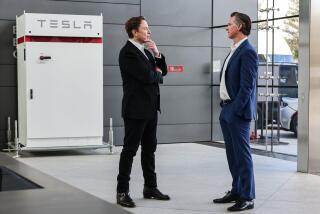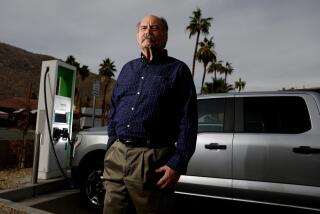Green technology investments lead third-quarter venture funding
Getting investors excited about long-lasting batteries was a challenge for Leyden Energy in the early days. Raising funds was even harder.
Then came the iPhone.
The popularity of Apple’s mobile device and other smartphones sent engineers into a frenzy to create batteries that could outlast the power hogs. The Fremont, Calif., lithium-ion battery company was already working on a solution, and as a result it recently raised $20 million in venture funding.
Energy storage companies such as Leyden Energy led clean technology investment during the third quarter by raking in $421 million in venture capital, a 1,932% increase from the same period last year, according to an Ernst & Young report.
In the race for investment dollars, the green sector is winning. Venture capitalists, reassured by federal legislation and state regulations, view clean technology as a safe bet, analysts said. Even as investors scale back funding in many other sectors, they continue to shower green companies with money. The National Venture Capital Assn. reported in October that third-quarter venture funding declined to its lowest point in eight years, to $1.7 billion from $3.5 billion a year earlier.
“Some of the trepidation about the overall state of the economy is starting to subside a little bit,” said John Gartner, a research director for Pike Research. “And it is time to get back into the market, and clean tech is an area that still has a lot of upside.”
In total, firms in the green sector raised nearly $1.2 billion in funding in the third quarter, a 73% increase from a year earlier, Ernst & Young reported.
The driving force behind growth in clean tech investing is an increase in demand stimulated by government regulation, analysts said. Investors said programs including the Department of Energy’s government-backed loan program for renewable energy projects signaled the federal commitment to clean tech.
On the local level, states are mandating renewable portfolio standards, in which utilities are required to obtain a portion of their energy from renewable energy sources.
Gov. Jerry Brown said he wants California to produce 12 gigawatts — enough to power about 3 million homes — of electricity from local clean power sources, such as rooftop solar panels, small wind turbines and fuel cells, by 2020.
Companies such as SolarReserve are reaping the benefits of these mandates. The Santa Monica company raised $15 million in the third quarter. In addition, it raised $27 million in October and secured a $737-million loan guarantee from the Department of Energy last December.
SolarReserve, founded in 2007, needs the funds to complete a solar power plant and work on additional projects. The company plans to use billboard-sized mirrors to gather energy from the sun and use molten salt to store energy for later use.
Kevin Smith, the company’s chief executive, said that SolarReserve has not experienced problems raising capital in the wake of the Solyndra scandal. Solyndra, a solar energy company, received a $535-million government-backed loan and later filed for bankruptcy.
Before breaking ground on its plant, SolarReserve had secured a 25-year deal with NV Energy in Nevada to generate power mostly for Las Vegas casinos.
Judith Albert, executive director of Environmental Entrepreneurs, said clean tech investors were not shaken by the Solyndra controversy.
Venture capitalists “are used to working in an environment of uncertainty, and they don’t expect all of the investments that they make to work,” she said. “And particularly in this case, when you are doing something as revolutionary as changing the way we deliver energy. There are going to be a few stumbles.”
As for Leyden Energy, the company recently started selling its batteries for consumer electronics through Canada-based Dr. Battery.
A typical lithium-ion battery can be charged 350 to 400 times before its performance starts to weaken. Batteries produced by Leyden Energy can be recharged more than 800 times until performance begins to deteriorate.
Aakar Patel, chief executive of Leyden Energy, said its partnership with Dr. Battery has exceeded the company’s “wildest expectations.” Though no cellphone manufacturers currently use batteries created by Leyden Energy, Patel said, major electronic companies are testing its products for use in later models.
“Consumers are using batteries more and more,” he said. “So batteries finally have to get better.”
angel.jennings@latimes.com
twitter.com/LATangel
More to Read
Inside the business of entertainment
The Wide Shot brings you news, analysis and insights on everything from streaming wars to production — and what it all means for the future.
You may occasionally receive promotional content from the Los Angeles Times.











